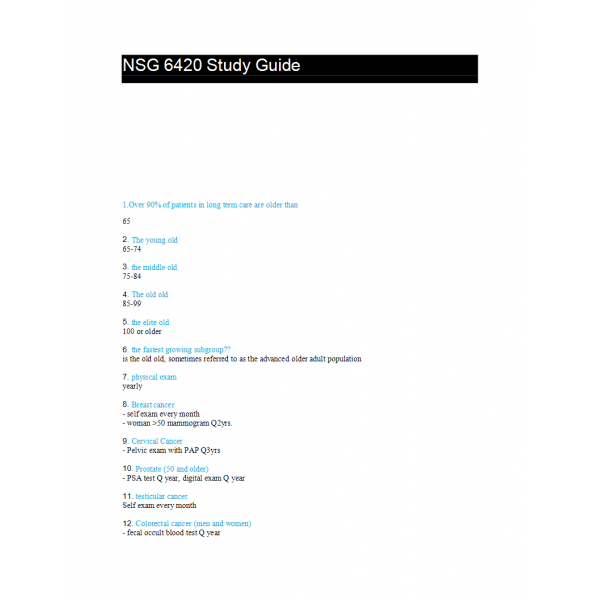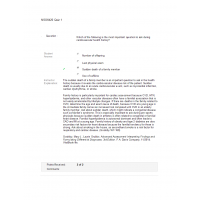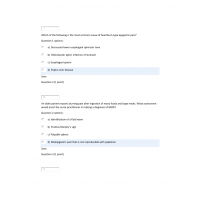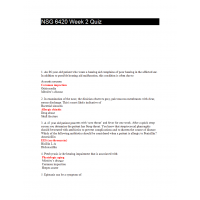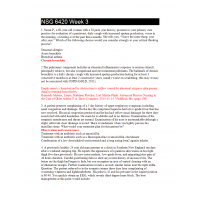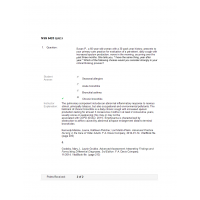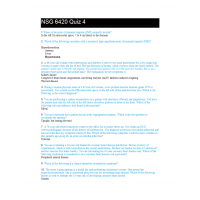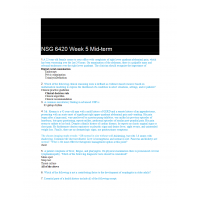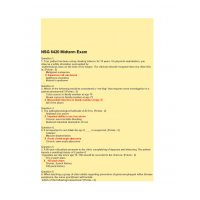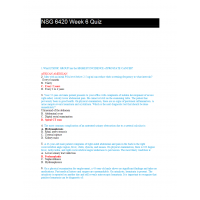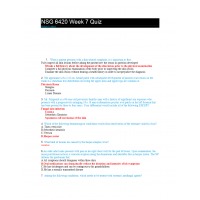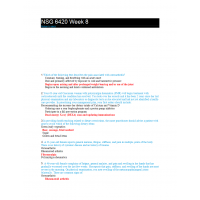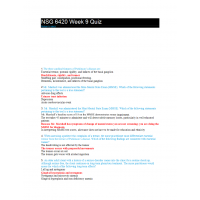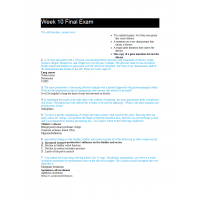NSG 6420 Final Exam Study Guide
1. Over 90% of patients in long term care are older than
2. The young old
3. the middle old
4. Th old old
5. the elite old
6. the fastest growing subgroup??
7. physical exam
8. Breast cancer
9. Cervical Cancer
10. Prostate (50 and older)
11. testicular cancer
12. Colorectal cancer (men and women)
13. Skin Cancer
14. oral cancer
15. Oral cancer
16. Bone density
17. Vision
18. Immunnizations
19. Genetic Theory
20. Immunity Theory
21. Cross linkage theory
22. free radical theory
23. KATZ
24. Stages of Alzheimer's: Stage 1
25.Stages of Alzheimer's Stage 2
26. Stages of Alzheimer's Stage 3
27. what can happen to dentures with aging
28. Older adults need an increased amount of what nutrients
29. Diminished senses can lead to what?
30. pre albumin
31. Albumin
32. total lymphocyte count
33. geriatric failure to thrive
34. maintaining appropriate levels of physical activity can decrease what?
35. Relocation syndrome
36. Home modifications that can help prevent falls
37. presbyopia
38. what are some things to be aware of with a decrease in the sense of touch
39. what are some common drugs older adults take OTC
40. age related changes that can potentially affect absorption of drugs orally
41. Age related changes that affect drug distribution
42. older adult changes in drug metabolism
43. excretion of drugs as it related to aging
44. normal creatinine clearance for men and women
45. Common adverse drug effects on the elderly
46. when preforming a medication assessment of an older adult what are some drugs the nurse should ask if the pt is taking
47. BEERS
48. depression and the older adult
49. what are some signs of depression the the older adult
50. drugs for depression
51. without TX what can depression result in
52. dementia
53. dementia
54. delirium
55. some of the factors that can cause delirium
56. how often should the older adult be in the sun
57. how much calcium should the older adult have
58. Baby boomers
59. what are some psychosocial concerns for the older adult
60. functional aging
61. Normal physical changes of older adults: General status
62. Normal physical changes of older adults: integument
63. Normal physical changes of older adults: musculoskeletal
64. Normal physical changes of older adults: neurologic
65. Normal physical changes of older adults: cardiopulmonary
66. Normal physical changes of older adults: Genitourinary
67. risk factors for alzheimer's
68. Spices Framwork
69. seborrheic keratosis
70. seborrheic dematitis
71. cherry anginoma
72. actinic lentigines
73. actinic purpura
74. bruising
75. arcus senilis
76. blepharitis
77. what are some interventions to promote sleep
78. stress incontinence
79. urge incontinence
80. overflow incontinence
81.Mixed incontinence
82. functional urinary incontinence
83. factors contributing to urinary incontinence
84. Interventions for incontinence
85. describe some sleep changes in the older adult
86. things to be aware of when implementing pain interventions and the elderly
87. Iron deficiency anemai
88. ACD
89. ACD
90. GINA Bill
91. Physiological changes of aging
92. X-linked Dominant
93. Autosomal Recessive
94. Dysmorphology
95. First Step for family genome assessment?
96. Health History includes?
97. Biotransformation(metabolism)
98. First symptoms of HIV?
99. Cardiovascular risk factors
100. Blood sugar screening
101. S1
102. S2
103. S3
104. S4
105. Posterior drawer test
106. Systolic Murmurs
107.
108. Murmur Red Flags
109. Signs of Aortic Stenosis
110. mitral valve prolapse (MVP)
111. Most common oral precancerous lesion?
112. Frozen Shoulder (Adhesive Capsulitis)
113. MVP sxs
114. Moderate-intensity statin therapy
115. Moderate to high intensity statin therapy
116. Most accurate diagnosis for pancreatitis?
117. When is Niacin used?
118. Grave's disease
119. H. pylori gastritis: treatment
120. Anterior Drawer Test
121. Presbycusis
122. How often do you check PSA levels?
123. Tinea Capitis Treatment
124. Keratitis
125. Bacterial conjunctivits
126. Allergic conjunctivitis
127. Viral conjunctivitis
128. Amaurosis fugax
129. Most common cause of eye redness?
130. Warnings for eye redness
131. clinical manifestations of UTI
132. Isolated Systolic HTN in elderly
133. Screen for lipids
134. Mitral Stenosis
135. Hypertensive reinopathy
136. Diabetic reinopathy
137. cerumen impaction
138. Atopic disorders mediated by IgE with a histamine response. Histamine response is:
139. CURB 65
140. Which findings are not considered normal age related?
141. Common skin cancer found on the nose?
142. Centor criteria for GABHS bacterial pharyngitis
143. What are the signs and symptoms of Impingement syndrome?
144. Ischemic Heart Disease
145. Chronic stable angina
146. Prinzmetal angina
147. Unstable Angina
148. Nephrolithiasis
149. pyelonephritis
150. Gross hematuria + flank pain + palpable mass
151. BPH
152. Proteinuria
153. stress urinary incontinence (SUI)
154. #1 compliant of OA?
155. 20yo female with pain, tenderness, decrease ROM at neck, shoulder, and medial knee:
156. Ligament injury, "give-away", "pop"
157. De Quervain's tendonistis
158. Osteoarthritis
159. Differential diagnosis for knee pain?
160. Ottawa ankle rules (5 things)
161. Systemic Lupus Erythematosus (SLE)
162. Rotator Cuff Muscles (shoulder joint stabilizer)
163. subacromial bursitis
164. back pain: red flags
165. Subarachnoid hemorrhage (SAH)
166. First line of therapy for acute gout?
167. Migraine Headache
168. tension headache
169. Phenytoin (Dilantin)
170. Dementia Symptoms
171. Subdural hematoma in elderly
172. DPP-4 inhibitor
173. MOA of metformin.
174. GLP-1 agonists MOA
175. Thiazolidinediones
176. Sulfonylureas
177. Pancreatitis
178. Pleurisy
179. Left upper quadrant pain
180. Right upper quadrant pain
181. Hypersplenism
182. Cellulitis
183. Actinic keratoses
184. Basal Cell Carcinoma
185. Squamous Cell Carcinoma
186. Vitiligo
187. Major signs of melanoma
188. A group of furuncles?
189. Type 2 Diabetes
190. Men have faster and more efficient biotransformation of drugs and this is thought to be due to:
191. The major impact of the physiological changes that occur with aging is :
192. The cytochrome p system involves enzymes that are generally Inhibited by drugs :
193. Functional abilities are best assessed by :
194. Iron Deficiency Anemia (IDA) is classified as a microcytic, hypochromic anemia. This classification refers to which of the following laboratory data?
195. When interpreting laboratory data, you would expect to see the following in a patient with Anemia of Chronic Disease (ACD) :
196. The pathophysiological hallmark of ACD is:
197. The main focus of treatment of patients with ACD is:
198. In addition to the complete blood count (CBC) with differential, which of the following laboratory tests is considered to be most useful in diagnosing ACD and IDA?
199. Symptoms in the initial human immunodeficiency virus (HIV) infection include all of the following except:
200. Essential parts of a health history include all of the following except:
201. Which of the following clinical reasoning tools is defined as evidence-based resource based on mathematical modeling to express the likelihood of a condition in select situations, settings, and/or patients?
202. The first step in the genomic assessment of a patient is obtaining information regarding:
203. In autosomal recessive (AR) disorders, individuals need:
204. In AR disorders, carriers have:
205. A woman with an X-linked dominant disorder will:
206. According to the Genetic Information Nondiscrimination Act (GINA):
207. Which of the following would be considered a “red flag” that requires more investigation in a patient assessment?
208. Your 2-year-old patient shows facial features, such as epicanthal folds, up-slanted palpebral fissures, single transverse palmar crease, and a low nasal bridge. These are referred to as:
209. In order to provide a comprehensive genetic history of a patient, the NP should:
210. Vestibular
211. Vestibular Function
212. Vestibular Dysfunction
213. 5 Anatomical Sites for Vestibular Lesions
214. Reasons for vestibular dysfunction
215. Dysequilibrium
216. Nystagmus
217. Oscillopsia
218. Presbystasis
219. ***Vertigo
220. OT Scope of Practice
221. Entry Level Practitioners MUST have:
222. Entry Level Practitioner Vestibular Rehab Interventions
223. Vestibular Disorders
224. Objective Diagnostic Vestibular testing
225. Peripheral Vestibular Disorders
226. Central Vestibular Disorder
227. Systemic Disorders
228. Physician Subspecialties
229. Common Signs of Vestibular Problem
230. Vestibular labyrinth is located within what portion of the skull?
231. The semicircular canals within our inner ear are filled with what substance?
232. Peripheral Vestibular System
233. The bony labyrinth is filled with what type of fluid?
234. The membranous labyrinth contains:
235. What is the job of the 3 semicircular canals?
236. What is the job of the 2 otolithic organs (Saccule and Utricle)
237. Inside the Otolithic Membrane = Macula (A receptor)
238. Semicircular Canals & Co-Pairs
239. Vestibulo-Ocular Reflex (VOR) is an eye mvmt made in response to mvmt of which body part?
240. *Peripheral Vestibular System feeds what part of the Central Vestibular System?
241. Somatosensory System feeds what part of the Central Vestibular?
242. *Visual/Oculomotor System feeds what part of the Central Vestibular System?
243. Gaze Stabilization
244. Gaze Stabilization is achieved by:
245. Central Oculomotor Skills that contribute to Gaze Stabilization:
246. Central damage
247. Peripheral Damage
248. Benign Paroxysmal Positional Vertigo (BBV) is a common disorder of the:
249. Common Disorders of the Peripheral Vestibular System:
250. Nausea/Vomiting
251. Neurological symptoms
252. Auditory Changes
253. Interventions for Disequilibrium
254. BPPV
255. Vestibular Neuritis
256. How to assess for BPPV:
257. Disorders of the Central Vestibular System
258. Ischemic Diseases
259. Progressive Disorders
260. Wallenberg's Syndrome
261. OT Evaluation Skills for Vestibular Rehab
262. OT Interventions for Vestibular Rehab
263. What interventions resolve BPPV, eliminate vertigo and restore functional independence?
264. Epley Maneuver
265. Brandt-Daroff Exercises
266. Contraindications to performing Dix-Hallpike Test
267. What are the steps in treating BPPV?
268. Dix-Hallpike (Assessment)
269. Intervention activities for Disequilibrium:
270. Examples of disequilibrium movement intervention activities:
271. Goal directed activities for disequilibrium
272. 3 Normal Balance Strategies
273. Balance Interventions
274. Vestibular Hypofunction
275. Interventions for vestibular hyopfunction
276. Goal for vestibular hypofunction interventions
277. Vestibular Hyperfunction
278. Interventions for vestibular hyperfunction:
279. Goal for vestibular hyperfunction
280. Activities for HYPOfunction
281. Activities for HYPERfunction
282. Interventions for Vestibular Ocular Dysfunction
283. Goal for vestibular ocular dysfunction
284. Visual-Vestibular Interaction Interventions
285. Sharp Purser Test
286. How to administer the Sharp Purser Test
287. Positive Sharp Purser Test
288. Negative Effects of Chronic Pain
289. Pain Perception
290. Pain Perception
291. What does OT address in pain perception?
292. What do OTS address for pain perception?
293. Nociceptive Pain
294. Nociceptive Pain
295. Neuropathic Pain
296. Neuropathic pain
297. Biopsychosocial Model of Pain
298. Biopsychosocial Model of Pain
299. Loeser and Fordyce Four Pain Domains
300. Evaluation of Pain
301. Theoretical Approaches to Pain Management - Behavioral
302. Methods for Pain Management - Behavioral
303. Methods for behavioral pain management
304. Operant Strategies for Pain Management
305. Cognitive Behavioral Strategies
306. Cognitive Behavioral Strategies
307. Volar plate contracture (PIP Flexion contracture)
308.Rupture of FDP
309. Nonfixed position OT treatment
310. Fixed position OT treatment
311. What is swan neck deformity characterized by?
312. Rehab Protocol for Tendon Repair
313. Three types of Extensor Tendon Protocols
314. Three types of Flexor Tendon Protocols
315.Initial Splints for Tendon Repairs
316. Tendon Repair Protocol Phases
317. Cumulative Trauma Disorders
318. Three Stages of CTD
319. TX of CTD
320. Common CTDs
321. Common Peripheral Nerve Injuries
322. Tinel's Sign
323. Phalen's Test
324. Reverse Phalen's
325. Positive Phalen's Test-Reverse Phalen's
326. Radial Nerve Innervates what muscles?
327. Median nerve innervates what muscles?
328. Ulnar nerve innervates what muscles?
329. Three Response Variables
330. Pyschosocial Concerns with Disability
331. Self-determination
332. Interdependence
333. Disability Vs. Chronic Illness
334. What factors contribute to a person's ability to adapt?
335. Values and Beliefs that guide psycho social aspects of disability
336. Kubler Ross Loss Stages
337. Short term psychosocial reactions reactions
338. Intermediate psychosocial reactions
339. Longterm psychosocial reactions
340. Adaptive responses
341. Maladaptive responses
342. Shock
343. TX approaches for shock
344. Defensive Retreat or Denial
345. Tx approaches for Defensive Retreat or Denial
346. Depression or Mourning
347. TX approaches for Depression or Mourning
348. Suicidal ideation
349. Regression
350. Personal Questioning and/or Anger
351. TX approaches for Personal questioning/Anger
352. Integration and Growth
353. TX approaches for Integration and Growth
354. Disability communities
355. Disability rights movement
356. Independent living (IL) movement
357. Independent Living Centers (ILC)
358. Self-advocacy
359. Self-advocacy Intervention
360. Ombudsman
361. Employee assistance program
362. Legal aid societies
363. Teaching Self-Advocacy to Support Adaption to Disability
364. Pain Definition
365. Acute pain
366. Chronic Pain
367. Mixed Pain
368. Biopsychosocial Model - Loeser and Fordyce: 4 Pain Domains
369. Evaluation of Pain (Subjective)
370. Evaluation of pain (objective)
371. Behavioral Approaches to Pain Management
372. Physical Agent Modalities (PAMS)
373. Operant Strategies (Behavioral)
374. Secondary Gains (Operant)
375. How do OTs use Operant Strategies?
376. Cognitive Behavioral Techniques
377. MOHO Approaches to Pain Management
378. Chronic pain may be complicated with:
379. Graded activities for Chronic Pain
380. Quota Programs and Chronic Pain
381. Relaxation Training
382. Biofeedback
383. Other Pain Management Interventions
384. Congenital Amputations
385. Acquired Amputations
386. UE Amputations
387. LE Amputation
388. Levels of UE Amputation
389. Levels of LE Amputation
390. Factors that Impact Rehab
391. Phantom limb
392. Phantom Sensation
393. Pre-Prosthetic OT
394. Immediate Post Surgical Fitting
395. Sensory Deficits & Interventions
396. Hypersensitivity
397. Desensitization
398. Mandy Case Study OPHII Scale
399. Mandy Case Study WRI Scores
400. Mandy's Case Study narrative slope:
401. OPHI-II
402. WRI
403. Mandy Case Study LTGs
404. OT Intervention for Mandy Case Study
405. Non-adherent Behavior
406. Underlying Meaning of non-adherent
407. Therapeutic responses to non-adherent behavior
408. Manipulative-Dependent Behavior
409. Underlying meaning of manipulative-dependent behavior
410. Therapeutic response to manipulative-dependent behavior
411. Cognitive Training tends to be impairment based or occupation based?
412. Cognitive Rehab tends to be impairment based or occupation based?
413. Impairment Based
414. Occupation Based
415. OT Interventions
416. Cognitive Orientation to Daily Occupational Performance
417. Task Specific Strategy (CO-OP)
418. Metacognitive Strategies
419. Metacognitive Interventions for the PERSON
420. Metacognitive Interventions for the ENVIRONMENT
421. How to Facilitate Transference of Learning
422. How to improve Self-Awareness
423. Specific Self-Awareness Intervention
424. A patient presents with a sudden onset of unilateral eye pain and blurred vision. You should suspect:
426. Acute glaucoma
427. Cataracts
428. S/S of cataracts
429. Contributing factors of cataracts
430. Chronic glaucoma
431. Glaucoma drugs
432. epistaxis
433. Sensorineural Hearing Loss
Conductive Hearing Loss (CHL):
435. Conductive Hearing Loss
436. hordeolum
437. Chalazion
438. Chalazion
439. Age-related Macular Degeneration
440.Age Related Macular Degeneration
441. *Retinopathy
442. allergic rhinitis
443. Treatment of allergic rhinitis
444. visual field testing
445. Retinal Imaging
446. Retinal Nerve Fiber Analysis
447. Fluorescein angiography
448. Electro-oculogram (EOG)
449. Electroretinography (ERG)
450. Eye and Orbit Sonograms
| Institution & Term/Date | |
| Term/Date | South University |
-
$75.00

